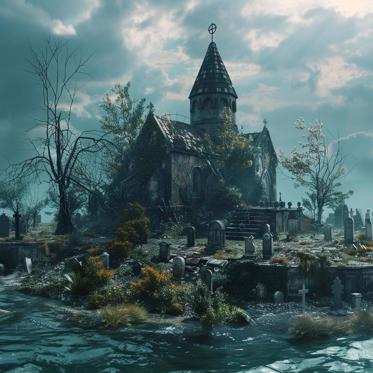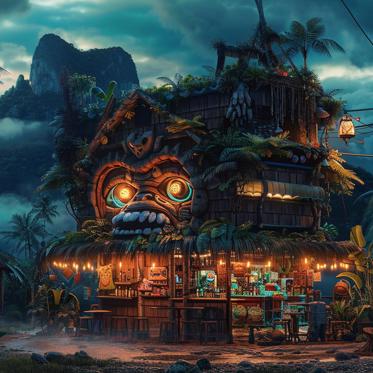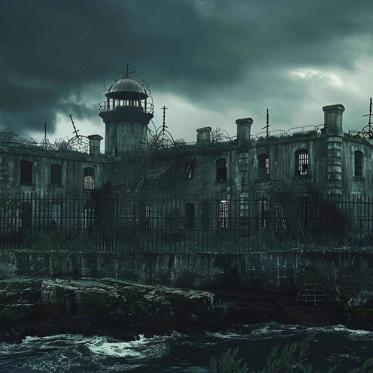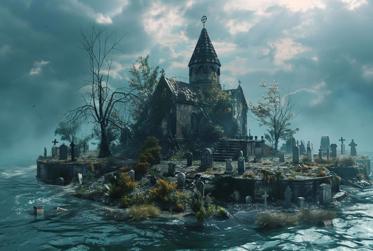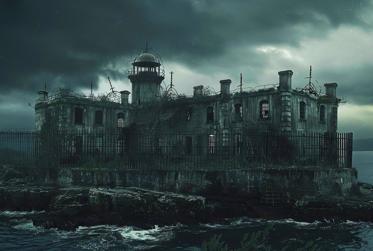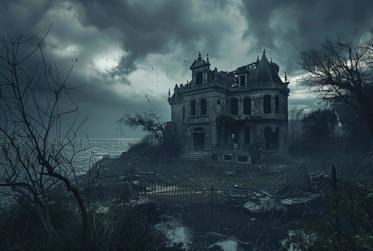There are many haunted islands out lurking over the horizon, and I covered some of these in Part 1 of this series, but there are far too many to contain in one article, so here we go off again across the dark waters of the supernatural to find some of the most haunted islands in the world.
One of the most intensely haunted islands in the world lies in the region of the Great Lakes, in the United States. Mackinac Island is a 3.8 square-mile island that lies tucked away on the western tip of Lake Huron at the eastern end of the Straits of Mackinac, in the U.S. state of Michigan. Lying right offshore from the base of Michigan's upper peninsula, just a 20-minute ferry ride from the city of Ignace, the island has a year-round population of only around 492. However, during the summer months, the island is deluged with tourists, who come to see the abundant nature offered by Mackinac Island State Park, which covers over 80% of the land here and is the nation’s second oldest state park after Yellowstone, as well as the numerous immaculately preserved, renovated, and restored historical spots and buildings, with the island being listed as a National Historic Landmark. With its ordinances enacted by The Mackinac Island State Park Commission that require landowners to preserve the Victorian look of the buildings on their land as well as a ban imposed since 1898 on all motorized vehicles except snowmobiles in winter and emergency or construction vehicles, Mackinac Island has managed to maintain its quaint, charming historic look and appears very much today as it would have back during early European settlement of the island.
Yet beneath this serene veneer of a quiet island frozen in time, there is a rather tumultuous and violent history that seems to lend itself to spooky stories of hauntings. Findings of various archeological artifacts such as pottery, arrowheads, and fishhooks have shown that Native Americans inhabited the island since around 900AD, or around 700 years before the arrival of Europeans in the 17th century. The name Mackinac came from these early tribes, with their word Mish-la-mack-in-naw meaning “Great Turtle,” which they thought the rocky island resembled. The island was a highly sacred place thought by the local Anishinaabe tribes to be the home of Gitche Manitou, or the "Great Spirit," and many burial grounds were established on the island for top-ranking members of the tribe, the locations of which have not been completely determined and some of which likely remain out there underfoot somewhere.

By the time early European explorers arrived in the mid-1600s, Mackinac Island had been mysteriously deserted, the tribes that once held the land in revered awe leaving behind only the bones of their tribal chiefs within the earth. The island was used extensively by the French as a strategic trade position on Lake Huron, with the Straits of Mackinac considered a valuable location for the fur trade. The island would be acquired by the British during the French and Indian War and go on to become a British stronghold during the Revolutionary War. It would then pass into American hands with the Treaty of Paris in 1783, and later would be the scene of numerous bloody battles between British and American Forces during the War of 1812, one in which the British captured the island and others in which many Americans were slaughtered trying unsuccessfully to recapture the strategic location. It would not be until 1815 that ownership of the island would fully and permanently pass into the hands of the United States, with the Treaty of Ghent, after much blood had been spilled.
One may think that with all of the ancient Indian burial grounds and the violent history of battle on the island, it could already be considered a sinister and cursed place, yet despite this dark past Mackinac Island went on to become a very popular tourist location for residents of the Great Lakes area in the wake of the Civil War. In response to the influx of visitors, hotels, railroads, boat landings, summer cottages, restaurants, and souvenir shops, were industriously built all over the island, and it became a premiere resort area for the wealthy. This popularity as a tourist location has not waned at all even into the modern day, and the sleepy little island comes roaring to life in the summer months with up to 15,000 visitors a day coming here to enjoy the historical sites, the state park, or the excellent fishing in the surrounding waters. However, what many of the tourists visiting this scenic, quiet little island where time has seemingly stood and horse-drawn carriages still roam the streets may not know is that it is not only intensely haunted, but has indeed been long considered to be one of the most haunted locations in the world for its size. Mackinac Island is literally crowded with alleged ghosts, and it seems that every house, inn, shop, church, alleyway, trail, bluff, dark corner, street, trail, outhouse, storehouse, and woods here has had some history of ghostly manifestations. In fact, it is hard to find a location on the island that is NOT said to be haunted. Ghost-infested locations are so numerous here that when writing an article on the haunted places of Mackinac Island it is hard to know even where to begin and there are far too many to comprehensively list here. However, some in particular stand out.

Perhaps a good place to start would be at the historical epicenter of bloody violence on the island, Fort Mackinac. The Fort was originally established by the British commander, Patrick Sinclair shortly after acquiring the island during the French and Indian War, and it was used as a military outpost during the Revolutionary War to protect the position from French-Canadians and native tribes, although it did not see combat at that time. The Americans would acquire the fort along with the island with the treaty of Paris in 1783, but the British would not readily give up such a strategically important outpost. They swooped in during the War of 1812 before the Americans had even become aware that war had been declared, easily ousting the totally off-guard and unprepared troops that had been stationed there. After that, Americans would suffer defeat and loss of life as they tried to regain the fortified position without success. It is also said that the British brutally massacred 72 natives here during the war. After Americans finally were granted the island and fort by the Treaty of Ghent in 1815, Fort Mackinac would go on to become a prison for Confederate sympathizers during the Civil War before finally being decommissioned in 1895.
Fort Mackinac is steeped in death, the very walls seem stained by it. In addition to the loss of life from battle or massacres that occurred at the fort, there were also the ones who died in the hospital there, often because the treatments of the time were crude and ineffective for a wide range of injuries and sicknesses. The hospital saw the death of not only soldiers but at least thirteen children of soldiers stationed on the island who died of Typhoid Fever, Tuberculosis, and other diseases, with one being only 5 months old. All of the bodies were buried at the nearby Fort Mackinac Post Cemetery. Other places of death can be found here as well. A dungeon for prisoners located in the Guard House and known as “The Black Hole” saw at least one prisoner die in captivity. On another area of the island, a Private Felix Pleave killed himself in 1843 and three pipers employed by the fort also died over the years here. Even the mess hall wasn’t free from death when a soldier stationed there by the name of James Brown shot and killed fellow soldier Hugh Flin during an argument. Brown would later be executed by hanging on a portable gallows set up at the Rifle Range just outside of the fort, although he insisted to the end that he had not meant to shoot Flin.
With all of the death permeating the place, Fort Mackinac makes a perfectly suitable location for a haunting, and indeed it has ghostly manifestations in spades. The halls of the fort often echo with the spectral laughing or giggling of children. The Officer Hills Apartment Quarters often experience moving furniture that slides about and sets off motion alarms, as well as lights seen flickering within after hours by security guards from outside, and the utterly chilling sound of babies crying in torment. In the cemetery, the apparition of a woman can sometimes be seen weeping at the grave of one of the children who died here, eternally lamenting her loss. The Guard House, in particular the dungeon jail, is known to have sudden and inexplicable cold spots and chills even in the stifling heat of summer, and orbs are frequently captured on camera here. It is suspected that this could be the presence of the long-dead prisoner still wallowing in his cell. People visiting the old hospital have reported smelling the stench of death, sickness, and decay, or of seeing disembodied limbs, which often show up in photos. At the North Sally Port Entrance Gate and Wall of the fort, it is said that the ghostly sound of piper music can be heard wafting through the air on foggy or misty mornings, that a phantom piper can be seen playing on the shore, and an entity of what appears to be a spectral young man in uniform can often be seen dutifully patrolling the walkway up on the defensive wall. At the Rifle Range Trail, there is an apparition dressed in an old-fashioned uniform, presumably the ghost of James Brown, the man who was executed here, that is said to follow people around and sometimes playfully trip up people by stepping on the backs of their shoes. The sounds of phantom rifles firing can also sometimes be heard at the Rifle Range. Additionally, the whole of the fort is plagued with various poltergeist activities such as children’s toys being rearranged, cameras malfunctioning, personal belongings flung around, furniture moved or even toppled over, and lights inexplicably turned on and off among others. There have even been reports of capturing disembodied voices speaking the Native language of Ojibwa here.

Another area that is considered to be one of the best on the island for experiencing paranormal phenomena is the Mission Point Resort, located on a bluff on the east side of the island. The resort has an interesting history. The area was first developed in 1827 as a missionary school for children of mixed Native American-European race. In the 1950s, the whole area was extensively developed into a world conference center for an evangelist group promoting world peace called The Moral Re-Armament, which subsequently moved its base of operations to Switzerland and in 1966 the site briefly became the location of Mackinac College. In 1970 the college was purchased by an evangelist by the name of Rex Humbard, who envisioned making it into a fancy religious retreat, but this would fall through and in 1972 the land began to be developed as a vacation resort. In 1977, an investment firm bought the land and changed it to the Mackinac Hotel and Conference Center, and in 1987 the property was sold again and given the name Mission Point Resort, after which its popularity as a hip vacationing spot skyrocketed. It is also home to one of the most haunted places on the island.
One of the most notorious ghost haunts at the Mission Point Resort is the Island House Hotel. One of the most popular spooky stories about the hotel is that a student in the late '60s or early ‘70s of what was then Mackinac College, known only as Harvey, proposed to his girlfriend and was cruelly rejected in front of his friends. Some say that the girl was cheating on him and this caused her to spurn his advance. The dejected and heartbroken young man is then said to have made his way to a high bluff behind the hotel and depending on who you ask either jumped to his death, hung himself, or shot himself in the head. Some rumors say that he was murdered, perhaps by his girlfriend’s secret lover, since it had been alleged that he was found with two bullet holes through his head, one through the temple and one entering the bottom of the chin and exiting the back of the head. Since then it is said that his ghost prowls the grounds of the resort. He is often seen on the bluff behind the hotel, or in the resort’s sound stage and theater and is said to be rather playful, seeming to enjoy playing practical jokes on visitors or guests to the hotel, with some of his favorites being turning on the lights while guests are sleeping, hiding personal belongings, or rearranging items or even furniture. There is also purportedly a room at the Island House Hotel with a bed that shakes so frequently and violently that it has been bolted to the floor and the wall, although whether this has anything to do with the ghost of Harvey is anyone’s guess.
Harvey is not the only ghost present at the Mission Point Resort. There is also allegedly the ghost of a little girl known as Lucy, who legend has it became sick on the island while her parents were away on business in Detroit and died before they could return. Lucy is most often seen frolicking about in the theater, the auditorium, and on the balcony of the Island House Hotel. Many visitors have also reported hearing the disembodied voice of a little girl calling for her mommy and daddy in various areas around the resort. Adding to the group are the apparitions of soldiers who are sometimes reportedly seen wandering around the resort.
The haunted Mission Point Resort was famously investigated by the crew of the SyFy Channel TV show Ghost Hunters, who call themselves The Atlantic Paranormal Society, or TAPS, on an episode titled “Frozen in Fear.” The team was able to uncover some weird phenomena there, and a 2010 investigation by the Michigan Area Paranormal Investigative Team also recorded strange occurrences here, including objects moving on their own, lights turned on and off in the presence of people in the room, and anomalous noises, which they deemed to all be solid evidence of something paranormal going on.

There are numerous other haunted hotels, inns, and bed and breakfasts on Mackinac Island as well. During the construction of the Grand Hotel, it is said that a large number of skeletons were dug up when the foundation was being made, and ever since there has been various ghostly activity reported here. It is believed that the skeletons were either from an Indian burial ground or were bodies that were left behind when the island’s Old Post Cemetery was relocated. Another hotel, the Murray Hotel, is supposedly haunted by the spirit of a woman who was strangled, sexually assaulted and murdered in her room, and whose murder has never been solved. Located on a high bluff on the west side of the island is The Inn at Stonecliffe, which is a popular place for couples to have weddings. The inn is supposedly haunted by the ghosts of a servant and a little girl, as well as the vengeful spirit of a woman who came to the island to be married only to have her British fiancee die before the wedding, which has caused her in her bitterness to allegedly cause mischief and try and ruin the weddings of happy couples who come here to tie the knot.
There is also a small and romantic bed and breakfast here called Small Point Cottage, which was originally built in 1882 and was originally a private residence. In 1971, a teacher named John Findlay came to Mackinac Island to teach at Mackinac Island Elementary School and purchased Small Point Cottage. The Findlays were subsequently tormented by profuse poltergeist activity including moving furniture, strange sounds, voices, and things suddenly going missing, all of which are thought to have been caused by the ghost of a girl who once lived there and had vowed to someday return, alive or not apparently. Years later, the house would be converted into the bed and breakfast it is today and guests often have experiences with ghostly activity here. The ghost of Small Point Cottage is said to be rather benign, non-threatening, and playful more than scary, leading visitors to actually want the entity to come out and play. Other haunted bed and breakfasts on Mackinac Island include Bogan Lane, which is haunted by a long-haired little girl who purportedly plays the piano and tells guests she wants to go home, as well as the Bailey House, where startled guests experience objects falling off counters, the sound of things sliding about in the attic, and the ghostly figure of a woman who allegedly peeks through windows into bedrooms.
Haunted cottages seem to be a thing on Mackinac Island. Another haunted cottage is the three-story, 42-room Pine Cottage, which was purchased by Bob Hughey in 1962 and was used as a private residence and restaurant he owned called Little Bob’s. Not long after moving into the house Hughey and his wife began to experience a multitude of strange phenomena such as hearing disembodied footsteps or the sound of doors slamming open or shut when no one was there. On one occasion, Hughey claimed that the apparition of a woman only visible from the waist up rushed past him from a closet and out of the window, nearly knocking him down in the process. The hauntings became steadily more intense, with additional sightings of a little girl crying all over the house and the ominous appearance of shadowy men standing beside beds, as well as personal belongings disappearing and covers suddenly, violently ripped off of beds. Eventually, the shaken Hugheys had had enough and moved away to St. Ignace, Michigan in 1995, but to this day many of these strange phenomena are witnessed by tourists visiting the spot. One creepy detail to this case is that it is said that a previous owner of the cottage was brutally murdered here in 1942 and the murder was never solved.
There are countless other haunted locations all over Mackinac Island. The Mission House was built by early settlers in the center of a Christian Mission which aimed to convert the local Native tribes to Christianity. At the time, a tuberculosis epidemic hit the mission, and sick Native children were locked up in the dank depths of the basement because it was thought that the cool, damp air would alleviate their symptoms. Not surprisingly, many of these children died down there in the dark. In later years the Mission House was converted into state employee housing and residents have long reported that the basement and first floors are heavily infested with the ghosts of young children, whose shadowy forms can be seen enthusiastically running about the halls, playing in the yard, and whose footsteps, giggling and laughing can often be heard, usually at night. There are also numerous instances of objects being knocked over or of alarm clocks suddenly going off on their own. The children ghosts of Mission House are said to be very non-threatening and friendly.

One of the creepier haunted places is already sinister from its name; The Drowning Pool. In the 1700s and early 1800s, seven promiscuous women who exchanged sex for money had been luring soldiers and fur traders, married or not, into their houses and were accused of being witches. Back in those days, one of the most popular methods for determining if someone was a witch or not was to simply tie rocks to their feet and throw them into water to see if they would float or not. Unfortunately, this was typically a lose-lose situation for the accused. If they sank, they were deemed innocent but often drowned in the process. If they floated, they were said to be witches and were then promptly hanged. So the seven accused women in this case were thrown into a lagoon on the island between Mission Point and downtown to see if they were witches, and all of them sank and drowned. Good news, they were not witches! Bad news, their vengeful spirits apparently haunt the dark waters of the lagoon to this day. Visitors tell of seeing mysterious huge splashes too big to be from fish, shadows creeping across the water’s surface without causing ripples, or strange dark figures floating just under the surface. It is considered to be one of the scarier and more malevolent places on Mackinac Island, with some people sensing a palpable evil dread here.
The list of haunted locations on the island goes on and on. Nearly as creepy as the Drowning Pool is the haunted ruins of a staircase and cave located in some woods on the island, where people have unwittingly photographed blurry figures and felt sudden chills. The entire North Side of the island is also said to be packed with the ghosts of natives who were massacred by the British during the War of 1812. These restless native spirits are often sighted running around through the forest howling, perhaps for revenge on those who killed them. Marquette Park is also said to be haunted, and the story goes that when soldiers made a garden here back in the early colonial days they unearthed around 1,000 skeletons. The ghostly activity is so intense that it seems it cannot even be contained by the island, and nearby Bois Blanc Island is also said to be haunted by the entities of two AWOL British soldiers who were captured and slaughtered by natives.
I have only scratched the surface here, and Mackinac Island sports many, many other ghostly locales as well, enough that it would take many more articles to list them all. Bloody history and Indian burial grounds aside, why is this particular island so hopelessly, thoroughly haunted? What is going on here? Why are there so damn many ghosts? To many, it is simply that so many died here unjustly and are therefore doomed to remain restless and lost into death, or perhaps choosing to stay around because it is a familiar place for them. Some believe that the reason lies in the amount of tragedy that occurred here, which has saturated the place with enough pain and misery to imprint these events onto its reality. For others, it is merely the spooky old architecture and darkened old-fashioned buildings playing tricks on the imagination, flavored by the stories and legends of ghosts and specters. Attempts to try and look at the phenomena of the island more scientifically have suggested that the high concentrations of limestone here and the currents of the surrounding water may be having some sort of effect. Whatever the reasons may be, Mackinac Island remains a place with one of the highest concentrations of hauntings, if not the highest, in the world.
Those adventurous spirits looking for a glimpse of the unexplained or the macabre can easily access Mackinac Island by ferry. The recommended time to go is in the summer months, as the winters here become bitterly cold, most of the hotels, shops, restaurants, and other facilities close, and the population drops considerably in this season. Once at the island, it is not hard to find a myriad of ghost tour operations ready to guide you around the haunted places mentioned here and indeed many others. One outfit in particular, called Haunts of Mackinac, offers a total of four different tour packages; the Downtown Tour, the Mission Point Tour, The Midnight Tour, and The Hunt. During The Hunt, which is limited to those 18 or older, visitors are actually given ghost hunting equipment and encouraged to go out and collect evidence of the supernatural. The tour operation is run by a Mr. Clements, who also wrote a book that chronicles the ghostly places and history of the island in great detail of the same name, The Haunts of Mackinac. Or, if one is feeling particularly foolhardy, you can go off on your own and explore the historical haunted places or go off onto the many trails that lead into the scenic yet no doubt spooky forests here. Just remember, you are never really alone here, even when you think you are, for the ghosts of Mackinac Island are many, and they are always watching.

Mackinac Island is not the only purportedly haunted island of the Great Lakes. Lying out over the great expanse of water that is Lake Superior, is a windswept archipelago of 21 storm-beaten islands called the Apostle Islands. They are a place of breathtaking natural vistas and rugged scenery, hosting much natural splendor and a magnet for hikers, campers, boaters, kayakers, and other adventure seekers. It is also a place of historical significance, with old lighthouses set upon craggy perches, meant to keep ships from dashing upon the treacherous rocks, a job in which they were only sporadically successful considering the area’s track record of sunken ships. The area is also populated by numerous legends from both Natives and sailors alike, and the Apostle Islands have accrued a reputation as being some of the spookiest and most haunted places in the Great Lakes region.
Probably the most famous ghostly story from the Apostle Islands comes from one of the smallest of the bunch, a desolate, 2-mile-long slash of rock called Hermit Island, once known as Round Island and Ashuwaguindag Miniss, Ojibwe for "The Further Island" by the Native tribe. This place gets its Hermit namesake from an ex-fur trader and recluse known as William Wilson, who back in the 1840s took it upon himself to build a modest, ramshackle cabin out in the middle of nowhere. He went there to escape his miserable life, having lost his wife to illness and seeking to live apart from civilization. Eking out an existence in that lonely, forsaken place, this weird old man had only one friend, an explorer and translator for the local Ojibwe tribenamed Benjamin Armstrong, who lived on the nearby Oak Island. Armstrong would often stop by to check up on the old man and make sure he was still alive, as well as making sure he had supplies and a steady supply of booze, which he sold to passing fishermen and partook of himself. There was a rumor that Wilson was actually quite wealthy, and had a small fortune tucked away hidden somewhere on the island. Indeed, Armstrong had on several occasions seen Wilson haul out bulging sacks of coins worth a king’s ransom in the day, but he never asked about it and this is the way it was for many years.
One day in 1861, Armstrong noticed that the steady plume of smoke from Wilson’s cabin on the island had ceased. After weeks went by and no smoke, along with reports that no one had heard from Wilson in some time, Armstrong made his way out to that isolated island cabin with a search party, only to find Wilson crumpled up dead on his cabin floor, the apparent victim of a vicious murder. Armstrong told authorities that he thought it might have been someone looking for the hermit’s treasure, and after scouring the island no secret hoard of money could be found. Over the years, treasure hunters would flock to the island hoping to find some of the buried loot, and it was during this scramble to hunt for lost treasure that weird stories of the supernatural began to surface. Treasure hunters began to report seeing a spectral figure walking about the wilderness, as well as feeling intense feelings of being watched and the unshakeable feeling that they were not supposed to be there. There were also whispered rumors that the dead hermit had cursed the island and that treasure hunters were meeting with inexplicable and grisly early demises. To those who saw the apparition, it looked a lot like the very dead Wilson, and it was enough to scare many into never returning.
In later years, a wealthy magnate by the name of Frederick Prentice took charge of the island and established the Excelsior quarry to mine for brown sandstone. By all accounts, the quarry was a success at first, and brought Prentice loads of money, but the activity also seems to have seriously pissed off Wilson’s ghost. Miners increasingly began to tell tales of seeing the old man’s apparition, seeing strange orbs of light, and hearing loud bangs and booms from the gloom, as well as equipment breaking down for no reason, missing objects, and a much higher incidence of freak mining accidents than usual. At the same time, the large, opulent house that Prentice had just built on the island, called Cedar Bark Cottage, became ground zero for all manner of strange tales. One was that Wilson’s ghost actually chased away Prentice’s wife, who felt an inexplicable revulsion upon seeing the new home, and after that the supposed curse was in full effect as the mines began to have financial issues and were forced to close down, leaving Prentice with no other choice but to sell the island and move back to New York, leaving the house abandoned.

The curse seems to have remained. Hermit Island would later be bought by the Lake Superior Land & Development Company to be made into a Great Lakes resort, renovating the old Cedar Bark Cottage to be a hotel, but it all soon turned belly up when there was a lack of visitors. After that, it went through a string of owners, all of whom fell on hard financial times and were unable to tame the island, with it going through cycles of activity and inevitable abandonment, even though it seemed like a prime location for a resort area. Efforts to build housing on Hermit Island similarly failed, and to this day it remains mostly uninhabited, now falling under the jurisdiction of The Apostle Islands National Lakeshore protected area, operated by the National Park Service. Whether this was the doing of Wilson’s curse or not, there are sightings of his ghost roaming the wilderness there to this day. And so this little speck of land still lies out there, with all of its mysteries, alone and detached from reality as it always has been, perhaps haunted, perhaps not, but nevertheless with its own stories to tell.
Moving off to other parts of the world, nestled out among the rugged Orkney Islands off the north coast of mainland Scotland and surrounded by grey, tumultuous seas, is the tiny island of Eynhallow, known to the ancient Norsemen as Eyin Helga, or “The Holy Island.” The island itself is just a speck of rock really, sat between the much larger islands of Mainland Orkney and Rousay, measuring just 75 hectares (0.29 square miles) in area and just 40 feet above the waves, now uninhabited except by the flocks of seabirds for which it serves as a sanctuary in modern times. Other than some decrepit ruins of a 12th-century church and the skeletal remnants of long-abandoned houses, the barren, windswept slash of rocky, seaweed-strewn land is rather unremarkable at first glance, and one could easily pass it right by without giving it much thought, but this tiny island has long been considered a magical, haunted place steeped in lore, myth, and mysterious history.
Even before humans ever lived here, Eynhallow was seen as a cursed place by the Norse, viewed as the hunting grounds of evil spirits called the sea trows, which would attack anyone foolish enough to try and step foot here, and which had the ability to shapeshift into the witness’s worst fear and to be able to make the entire island vanish to keep it from prying eyes. In later centuries the island became known as the summer home of the Finfolk, which were aquatic beings similar to the common image of merfolk. The Finfolk were renowned for their shapeshifting abilities and feared for their propensity for abducting humans throughout the Orkney Islands to be used as slaves and spouses, taking the form of other sea animals, fishermen, or even floating clumps of seaweed or other debris to lure their victims closer before lashing out to grab them and take them to their lair. These Finfolk were only able to come ashore in the summertime, and they did so at Eynhallow, their summer sanctuary, which was called the Hildaland (Hidden Land) and which they were able to make invisible from human eyes or to wreath in a mystical fog.
It was said that to approach Eynhallow was to court with certain disaster, as the Finfolk would either kidnap or kill trespassers, and the island was seen as a cursed, forbidden place to be avoided, patrolled by the Finfolk and protected by dark magic. That is until the arrival of a local farmer called The Goodman of Thorodale. According to the tale, the farmer’s wife was chosen as a Finfolk mate and taken away against her will to Eynhallow, but he would not let it go that easily. The Goodman gathered up his sons and ventured out to the forbidden island, armed with both weapons and special charms to ward off the sorcery in place to protect it. Upon reaching the shore, the group went about performing a ritual that broke the spell the Finfolk had over the island and cast them out, and fighting off the ferocious Finfolk, finally making Eynhallow once again the rightful property of humans.

It was after this that a few people would begin trickling to make their meager homes here, and the chapel was erected here in the 12th century. Very little is actually known about the history of human habitation on the island other than that the stories and lore continued, with all kinds of rumors whispered among the people of the Orkney Islands that this was still a place of magic and menace. One account of this oddness comes from 1529 in the manuscript called Descriptio Insularum Orchadiarum, in which it is written of the eccentric Eynhallow:
It is of old times related that here, if the standing corn be cut down, after the setting of the sun, unexpectedly there is a flowing of blood from the stalks of the grain; also it is said that if a horse is fastened, after sun-down it will easily get loose and wander anywhere during the night.
The island remained an enigma, its history and reclusive people poorly understood and wrapped in riddles, its true past and origins almost totally contained within oral traditions that have long ago faded into the mists of time. It is known that by 1851 there were only a scant 26 people inhabiting this forsaken place and that a mysterious unknown disease, possibly typhoid, hit here to send them fleeing, taking their traditions and oral history with them. The roofs of the houses were removed and the land cleansed as much as possible of the scourge of the plague, but the people never did come back, leaving nothing but mysteries in their wake. The island became a sea bird sanctuary, and now the land is silent except for the screeching of the birds, the barking of seals, the roar of the wind, and the relentless crash of the rough waves that lash the shores.
Eynhallow is an inscrutable fossil from another age. With no written history to speak of, we are left to wonder about this place so permeated in dark legends and myths, and there are many things we have yet to understand. Even the church on the island is of enigmatic origins, thought to possibly have been an early Christian monastery but largely wreathed in the unknown, its true nature only truly known by people who are long gone. The crumbling, feral overgrown ruins of the cottages similarly offer no clue as to who these people were or their way of life, and adding to it all is the presence of odd, imported red sandstone fragments scattered about the dwellings, the purpose of which we can only guess at. Indeed, much of the island remains not fully explored, with hints of buried prehistoric sites and ancient walls still buried here waiting to be discovered yet still untouched.
In present times the island remains little studied and nearly inaccessible. No ferry goes to the island, and while it is not closed to visitors the only way to really get there is to take a private boat through the notoriously treacherous tides and rough seas, or one of the once yearly tours offered in July by the Orkney Heritage Society. Even in this modern age, this is an island that has remained wreathed in mystery and unsolved conundrums, and it lives on in the legends of the area. In many ways, whether the legends are true or not, this place remains the Hildaland, the secret lair of the Finfolk.
Moving over to Italy, Poveglia Island is one of the many small islands that dot the Venetian Lagoon of northern Italy and is located between Venice and Lido. The island is thick with a long, twisted, and tumultuous history that has a large shadow of evil and sinister goings-on looming over it. The first inhabitants here came in the year 421 AD in order to escape the barbarian hordes that were ravaging Venice at the time. It was not a peaceful lifestyle. These bedraggled early inhabitants were beset by the rampaging barbarians and regular fighting was commonplace as they fought to keep the hordes at bay.

In the 9th century, despite the huge amount of blood that had been spilled on its soil, Poveglia became more populous and was steadily inhabited for centuries until its people were displaced in 1379 in order for the government to use the island as a station with which to battle attacking fleets from the Genoese, with whom the Venetians had a long-standing bloody rivalry. The intimidating octagonal battlement that was erected for this purpose still stands today. There are also rumors that say Poveglia was used as a base by the English from which to ambush and slaughter French soldiers during the Napoleonic War, a claim which is somewhat supported by the various French shipwrecks still littering the bottom of the lagoon. It is said that French commandos who were captured were then brought onto the island and ruthlessly burned alive, adding to the turbulent violence that already plagued Poveglia’s past.
The island then remained uninhabited and mostly forgotten until the bubonic plague swept through Europe leaving death in its wake. The government, famous for its strict sanitary laws, turned several of the islands of the Venetian Lagoon, including Poveglia, into special quarantine stations, referred to as lazarettos, starting from 1403. These quarantine stations were typically used to confine people who displayed symptoms of the plague and were thought to be ill, after which if they were found to be healthy they could go on their way after a set time had passed and they had been given a clean bill of health, usually about 40 days. It is in fact the Italian phrase for 40 days, quaranta giorni, from which the modern term “quarantine” comes.
However, as the plague grew worse and the death toll mounted, these quarantine stations went from slightly unpleasant holding facilities to more like Hell on Earth. As the plague reached a furious pitch, those who exhibited even the slightest symptoms were banished to the island to live out their remaining days in agony, and the quarantine stations became dumping grounds for the thousands of rotting bodies that were left in the wake of the disease, which were thrown into hastily dug grave-pits and buried or burned. During the worst outbreak of the Black Death, between 1629 and 1631, an estimated 80,000 people perished in just 7 months, and the Venetian lazzarettos earned a reputation for being putrid pits of decomposing, diseased corpses and the sickly walking dead. As the panicked government desperately tried to staunch the spread of the disease, many people were dragged unwillingly away from their homes and families to be brought kicking and screaming to Poveglia to die or even be hastily thrown onto the many stacks of bodies that were being incinerated while they were still alive. The victims would live in squalid conditions, often in great pain and anguish, with the threat of being burned alive hanging over their heads and very little in the way of treatment from the somber doctors who patrolled the island wearing creepy long-nosed masks packed with herbal concoctions in an attempt to prevent contracting the illness themselves. Italy would eventually lose around one-third of its population to the plague, and many of the victims found their final resting places in the scorched, blood-soaked earth of Poveglia and other islands like it.
Even when the worst of the plague was over, Venice remained vigilant. In 1776, Poveglia was taken over by the Public Health Office, or Magistrato alla Sanità, and subsequently used as a quarantine checkpoint for all people and goods being transported by ship from the Adriatic Sea to the Venetian Lagoon. After two cases of the plague were found aboard ships in 1793, Poveglia was once again transformed into a confinement station for suspected victims until the lazaretto closed its doors in 1814. It is thought that over the island’s history during the dark years of the bubonic plague, the corpses of around 160,000 men, women, and children from all walks of life and levels of society ended up here, so many that it is said much of the island’s soil is composed of human ash.

By the 1900s, a dark history of death and decay already saturated the land here, but Poveglia had not yet seen the end of its morbid destiny. In 1922, existing buildings on the island were renovated and turned into an asylum for the mentally ill. Not long after, the patients here started complaining of seeing ghosts and hearing disembodied wailing voices, but at the time these claims were treated as merely the ranting of deranged, insane minds. Poveglia’s history as a psychiatric hospital contains a good deal of dark lore. It is said that one sadistic doctor there began performing demented experiments on the patients, and was convinced that lobotomies were a sound way to treat and cure whatever was ailing their tortured souls. The doctor allegedly conducted all manner of lobotomies on his unwilling patients, using tools such as hammers, nails, drills, and chisels, with very little of it having any sound theoretical basis and none of it done with any sort of attention to safety and sanitation. The doctor also purportedly performed other mysterious experiments on patients within the hospital’s bell tower, and it was not uncommon for patients to be kept awake at night by the screams of pain and despair emanating from the tower at night to add to those of the ghosts they already heard.
Things did not end well for the good doctor. The story goes that the doctor began to be harassed by ghosts, menacing shadows, and strange voices gibbering away in his head. After being driven stark raving mad from the constant phantom assault, it is said that the doctor proceeded to throw himself, or in some accounts was thrown by some unseen force, from the top of the bell tower, the very same one where he had committed his deranged atrocities. A nurse who purportedly witnessed the event would later claim that the doctor had survived the initial fall, but his twisted, broken body had then been wreathed in a mysterious mist as he lay there in agony which then violently choked him to death. A persistent rumor is that the doctor’s body was subsequently bricked up within the walls of the hospital. The asylum was closed in 1968, but a time-worn, washed-out sign reading Reparto Psichiatria (Psychiatric Department), still marks the location and serves as a reminder of its creepy past. The decrepit buildings also remain standing as well, complete with barred windows, stacks of abandoned, moldy beds and bedframes, and institutional, drably painted halls perhaps still prowled by the ghosts of long-dead lunatics.
Upon the closing of the hospital, the island was used mostly for agriculture, such as vineyards, and was only sporadically inhabited. The stories of those who have tried to purchase the island and live on it are surrounded by weirdness. One person who owned the island in the 1960s quickly abandoned it for unknown reasons and another family who had planned to build a vacation home here suddenly gave up on their dream. Although they would not elaborate on why they had abruptly decided not to live here (a history of plague, murder, and death perhaps?), rumor has it that the daughter of the family had mysteriously had her face split or ripped open while on the island, a grievous injury that had allegedly required 14 stitches. There has never been any explanation as to what happened to her to inflict such a wound, but the popular rumor is that some violent entity brutally attacked her.
With such a long, gruesome history of blood and misfortune, it is perhaps no surprise at all that Poveglia, with its spooky crumbling buildings overrun with weeds and its earth filled with plague pits and the skeletons of anguished souls, is considered to be intensely haunted. This is a place that exudes a sense of menace and malice. Many who come here report being immediately beset with a heavy feeling of dread and despair which seem to hang in the air like a tangible cloud. There are those who upon setting foot on the island are suddenly overcome with the uncontrollable urge to turn back and flee. There are also the reports of tortured wailing or moaning emanating from the island’s various dilapidated, darkened buildings, as well as the inexplicable tolling of the bell tower’s bell even when no one is there, an especially creepy thought considering the tower’s sadistic history. Some shaken witnesses have described picking around in the remains of the old asylum and being commanded by an unearthly voice to leave and never come back, and it is not uncommon for people to report seeing shadowy figures skulking about in the dim ruins of the island. Psychics who have visited Poveglia in particular have described it as a harrowing place filled with malignant, long-suffering, and very angry, vicious entities that seem to have a nasty and malicious disdain for trespassers. Most such psychics have found this potent, malevolent energy so unbearable and traumatic that they refuse to return.

Other ghostly encounters are more aggressive and physical. Reports of being brushed, nudged, or shoved by invisible hands are not uncommon, and there are cases of attacks by unseen forces that are almost brutal in nature. One of the most infamous ghostly incidents on the island was captured on film by the TV show Ghost Adventures, which surely got even more than they had bargained for. In 2009, the crew, along with host Zak Bagans, basically stranded themselves on the island for 24 hours to see what they could come up with and immediately had their equipment giving weird readings that were blazing off the charts. This was quickly followed by inexplicable equipment malfunctions and a pervasive, dire sense of dread that overcame all involved. The crew experienced disembodied voices and footsteps, EVP phenomena, and captured mysterious orbs on camera. So far, so creepy, but things apparently got even more out of hand when Bagans was wandering the island provoking the spirits in Italian when he was seemingly viciously assaulted by some unseen and obviously unfriendly entity that appeared to want to possess him. In the footage, the terrified Bagans can be seen flailing and trying to fight off whatever it is that is tormenting him with such rage. Although there is no way to prove that this was a real occurrence or that actual ghosts were involved, it certainly remains a remarkably eerie piece of footage.
Whether it is really haunted or not, Poveglia is certainly a place that invites fear and a sense of desolation. The buildings that remain here, including a church, bell tower, the hospital, housing for hospital staff, and administrative buildings, are in various states of decay, with only very fleeting efforts to maintain them or erect supports to stave off the entropy that threatens to send them toppling to the ground. Some of the buildings on the island are so choked with weeds and ivy that they are barely recognizable, instead appearing as mounds of vegetation with half-buried structures occasionally poking through like some ancient, forgotten ruin in a remote jungle. Within the buildings are nothing but murky corridors full of peeling paint, rooms with moldering abandoned furniture, torn, discarded books, rusty medical equipment, and various other debris, all covered in an ever-present film of dust and grime. Occasionally graffiti from illegal visitors to the island can be seen scrawled across walls. Outdoors, one is never far from the thought that they could be treading over one of the buried mass graves of countless plague victims or that much of the muck and soil here is permeated with human ash and blood. Sometimes skulls or skeletons turn up unearthed out in the open, are washed up on shore, or dragged up in fisherman nets in the surrounding waters; grim reminders of what this place once was. It seems that one is never far from the forgotten relics of death and decay on Poveglia. The place has a definite air of evil and if it is not truly haunted, then it somehow seems like it should be.
Currently, Poveglia Island is uninhabited and is used mostly for agricultural purposes such as vineyards. Its sinister rumors and history for the most part seem to do a good job of keeping most people at bay. It is said that fishermen tend to avoid the island and that the only time most people are willing to go there is to harvest the grapes in the island’s vineyards. For those that have a morbid curiosity or macabre fascination with the “Most Haunted Island in the World,” it is possible to venture there but due to the Italian government’s closure of the island to tourists it requires a special permit obtained through a load of arduous paperwork. Even having a permit is by no means a guarantee of reaching Poveglia, as few boats are willing to go there and those that do are expensive and intermittent. Despite the government’s ban on visiting the island, it has become a popular place for thrill seekers hoping to see something bizarre or ghostly. It seems distinctly odd that in the middle of one of the most popular tourist destinations in the world, among burgeoning resorts and just a stone’s throw away from Venice’s famous Grand Canal there is this rotting, neglected island of dread that no one goes to. Although Venetians have tried to downplay Poveglia’s creepy reputation and horrific past, the island is still seen by much of the outside world as a ghoulish, feral place full of dark death and dread.
This somber reputation and the lurid stories that circulate about Poveglia have proven to be a hurdle for those wishing to develop the island into yet another resort. In 2014, the Italian government announced that it would issue a 99-year lease to potential buyers in an attempt to ease its public debt, with the hope that any takers would turn the land into a tourist resort as has been done with other lagoon islands such as Sacca Sessola and San Clemente. Such plans have met opposition from locals, who resist the ever-tightening grip of mass tourism on their historic city, with many beloved locations transformed in recent years into mazes of luxury hotel resorts and souvenir shops populated by throngs of visitors and a cacophony of noise. At least one local group wants to turn the island into more of a relaxing recreational area rather than just another luxury resort, with two-thirds of the land available to the public for outdoor activities such as camping and picnicking. Locals hope to raise enough money to pay the lease and move forward with their plans. With the island’s horrific, gloomy past and persistent legends of specters and ghosts stalking its ruins, it seems that any plans to turn the spooky island into a resort or even a recreational area is likely to be a hard sell.
Once again we are left to ask what it is with these places that should lure so many dark and paranormal forces to them. Is it their history, their specific location, some quality imbued into the land itself, or something else? We will continue to explore more of these island anomalies in Part 3 of this series, so stay tuned.
Trending Podcasts
-
 31.17 I MU Podcasts
31.17 I MU Podcasts31.17 - MU Podcast - Battlefield Echoes Reborn
-
 31.18 I MU Podcasts
31.18 I MU Podcasts31.18 - MU Podcast - Bibhu Dev Misra
-
 +29.16 I MU+ Podcasts
+29.16 I MU+ Podcasts29.16 - MU Plus+ Podcast - Echoes of 401
-
 +29.17 I MU+ Podcasts
+29.17 I MU+ Podcasts29.17 - MU Plus+ Podcast - Sleepover Symbiotes
-
 31.16 I MU Podcasts
31.16 I MU Podcasts31.16 - MU Podcast - The Great Crop Circle Hoax
-
 +29.18 I MU+ Podcasts
+29.18 I MU+ Podcasts29.18 - MU Plus+ Podcast - Never Contact Me Again


